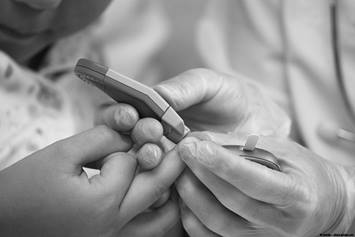Diabetes: Type 1
Type 1 diabetes is a chronic condition that occurs when your body makes little to no insulin.
What Is Type 1 Diabetes?
Our bodies are made up of many cells, and each cell needs sugar (glucose) for energy. Glucose comes from the food we eat. Insulin, a hormone made in your pancreas, is the key that helps glucose get into cells and make energy.
Type 1 diabetes is a chronic condition that occurs when your body makes little to no insulin. If your body does not produce enough insulin to keep your blood glucose at a normal level, the blood glucose rises: and diabetes results.
- Type 1 diabetes (formerly known as juvenile diabetes) is the most common type of diabetes in children, teens and young adults.
- Type 1 diabetes is an autoimmune disorder. This means the body attacks the cells that make insulin.
What Are the Signs and Symptoms of Type 1 Diabetes?
When blood glucose levels become high, some glucose leaves the body through urine. This causes many initial symptoms, which may include:
- Frequent urination (recurrent bed wetting)
- Thirst
- Dry mouth
When your body cannot use glucose for energy, you may:
- Feel tired
- Lose weight
When glucose cannot get into the cells, your body starts to use fat for energy. When fat is used for energy, your body makes ketones.
Ketones are in the blood and urine and can cause blood to have more acid. Acid in the blood leads to diabetic ketoacidosis (DKA) which can make you very sick.
When you have ketones in your blood, you may:
- Have a stomach ache
- Throw up (vomit)
If you have diabetic ketoacidosis (DKA,) you may:
- Feel sick
- Start to breathe fast
- Have a fruity smell to your breath
- Be difficult to wake up
- Feel confused or unable to pay attention
What Causes Diabetes?
The exact cause of type 1 diabetes is unknown. Experts believe you get certain genes from your parents that make type 1 diabetes more likely. These genes are not enough to give you diabetes. Something in the environment starts the process. We do not know what this is. The process may happen long before you get diabetes.
We do know type 1 diabetes is an autoimmune disorder. This means the body’s immune system mistakenly gets rid of the cells that make insulin.
Children, teens and young adults diagnosed with type 1 diabetes did nothing wrong to cause diabetes. There’s nothing they could have done to prevent it. There’s no way to “spread” diabetes, either.
How Is Diabetes Diagnosed?
If you have symptoms of diabetes, your doctor will check your blood sugar level. If it is high, this means you have diabetes.
Sometimes your doctor may be unsure about what kind of diabetes you have. If this happens, your doctor will run blood tests to check for autoantibodies. These indicate there is damage to the cells that make insulin. They occur in type 1 diabetes. Ketones in your urine also suggest type 1 diabetes. If you are sick and might have DKA, other lab tests will be done.
It may take many weeks for your doctor to confirm a type 1 diabetes diagnosis. It’s possible to have both type 1 and type 2 diabetes.
How Is Type 1 Diabetes Treated?
Type 1 diabetes is always treated with insulin. An insulin pump or multiple insulin injections each day will help you replace your body’s missing insulin and manage your condition.
If you have type 1 diabetes, you will need to keep your blood glucose as close to normal as you can. A normal blood glucose is 70 to 120 mg/dl. You will always need to take insulin to keep your blood glucose normal.
Your care team will help you learn how to:
- Check your blood glucose
- Take insulin
- Count carbohydrates in the foods you eat
- Learn what makes your blood glucose change
Managing type 1 diabetes is very important. If high blood glucose is not treated, glucose starts attaching to proteins in the body and causes organ damage. This affects the eyes, kidneys, heart, blood vessels and nerves. It happens after many years. The best way to make these less likely is to keep the blood glucose as normal as possible.
Can Diabetes be Prevented or Cured?
Currently, diabetes has no cure. But many researchers around the world are working hard to develop one.
Type 1 diabetes can be managed by insulin injections. If blood glucose is kept under control, then the complications of diabetes are less likely.
Better therapies are being developed, such as insulin pumps with continuous glucose monitors that check blood glucose every few minutes automatically. A new development is a combination continuous monitor and insulin pump. It adjusts the pump automatically to give insulin and keep the blood glucose level as close to normal as possible.
Insulin is produced by beta cells in the pancreas, and beta cell transplants are used in certain patients. These transplants can keep the glucose level more normal without taking insulin. There are risks associated with beta cell transplants. They are not for everyone yet.
When Should I Seek Help?
If you suspect your child has diabetes, talk to his or her pediatrician immediately.
Type 1 diabetes will not stop you from doing the things you like to do. Taking care of type 1 diabetes is a lot of work. It is important to do the work. High blood glucose over many years can cause permanent health problems.
Diabetic Ketoacidosis (DKA) can be very dangerous. If your child has DKA symptoms, contact your health care provider immediately or go to the emergency room.




